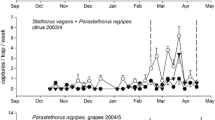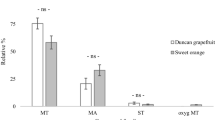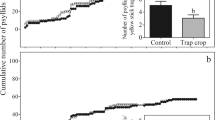Abstract
Ageratum conyzoides L. weed often invades cultivated fields and reduces crop productivity in Southeast Asia and South China. However, intercropping this weed in citrus orchards may increase the population of predatory mite Amblyseius newsami, an effective natural enemy of citrus red mite Panonychus citri, and keep the population of P. citri at low and noninjurious levels. This study showed that A. conyzoides produced and released volatile allelochemicals into the air in the intercropped citrus orchard, and these volatiles influenced the olfactory responses of A. newsami and P. citri. At test temperature (25°C), A. conyzoides fresh leaves, its essential oil, and major constituents, demethoxy-ageratochromene, β-caryophyllene, α-bisabolene, and E-β-farnesene, attracted A. newsami and slightly repelled P. citri. Field experiments demonstrated that spraying A. conyzoides essential oil emulsion in an A. conyzoides nonintercropped citrus orchard increased the population density of A. newsami from below 0.1 to over 0.3 individuals per leaf, reaching the same level as in an A. conyzoides intercropped citrus orchard. However, this effect could not be maintained beyond 48 hr because of the volatility of the essential oil. In contrast, in the A. conyzoides intercropped citrus orchard, A. conyzoides plants continuously produced and released volatile allelochemicals and maintained the A. newsami population for a long time. The results suggest that intercropping of A. conyzoides not only made the citrus orchard ecosystem more favorable for the predatory mite A. newsami, but also that the volatile allelochemicals released from A. conyzoides regulated the population of A. newsami and P. citri.

Similar content being viewed by others
References
A. A. Agrawal (2000) ArticleTitleMechanisms, ecological consequences and agricultural implications of tri-trophic interactions Curr. Opin. Pl. Biol. 3 329–335 Occurrence Handle10.1016/S1369-5266(00)00089-3
F. Augusto A. L. Lopes C. A. Zini (2003) ArticleTitleSampling and sample preparation for analysis of aromas and fragrance Trends Anal. Chem. 22 160–168 Occurrence Handle10.1016/S0165-9936(03)00304-2
J. Bruin M. W. Sabelis (2001) ArticleTitleMeta-analysis of laboratory experiments on plant–plant information transfer Biochem. Syst. Ecol. 29 1089–1102 Occurrence Handle10.1016/S0305-1978(01)00052-7
J. Bruin M. Dicke M. W. Sabelis (1992) ArticleTitlePlants are better protected against spider-mite after exposure to volatiles from infested conspecifics Experientia 48 525–529 Occurrence Handle10.1007/BF01928181
R. L. Bugg S. C. Phatak J. D. Dutcher (1990) ArticleTitleInsects associated with cool-season cover crops in southern Georgia: implications for pest control in truck-farm and pecan agroecosystem Biol. Agric. Hortic. 7 17–45
M. Dicke (1999) Evolution of induced indirect defense of plants R. Tollrain C. D. Harvell (Eds) The Ecology and Evolution of Inducible Defense Princeton University Press Princeton, NJ 62–88
M. Dicke M. W. Sabelis J. Takabayashi (1990) ArticleTitlePlant strategies of manipulating predatory–prey interactions through allelochemicals: Prospects for application in pest control J. Chem. Ecol. 16 3091–3188 Occurrence Handle10.1007/BF00979614
O. Ezquerro B. Pons M. T. Tena (2003) ArticleTitleMultiple headspace solid-phase microextraction for the quantitative determination of volatile organic compounds in multiplayer packagings J. Chromatogr., A 99 155–164
R. E. Fye (1983) ArticleTitleCover crop manipulation for building pear Psylla (Homoptera: Psyllidae) Predator populations in pear orchards J. Econ. Entomol. 76 306–310
G. J. House M. D. R. Alzugaray (1989) ArticleTitleInfluence of cover cropping and no-tillage practices on community composition of soil arthropods in a North Carolina agroecosystem Environ. Entomol. 18 302–307
A. Janssen (1999) ArticleTitlePlants with spider-mite prey attract more predatory mites than clean plants under greenhouse conditions Entomol. Exp. Appl. 90 191–198 Occurrence Handle10.1023/A:1003551931509
A. Kessler I. T. Baldwin (2001) ArticleTitleDefensive function of herbivore-induce plant volatile emissions in nature Science 291 2141–2144 Occurrence Handle10.1126/science.291.5511.2141 Occurrence Handle11251117
C. H. Kong F. Hu T. Xu Y. H. Lu (1999) ArticleTitleAllelopathic potential and chemical constituents of volatile oil from Ageratum conyzoides J. Chem. Ecol. 25 2347–2356 Occurrence Handle10.1023/A:1020882109682
C. H. Kong F. Hu X. H. Xu (2002) ArticleTitleAllelopathic potential and chemical constituents of volatile from Ageratum conyzoides under stress J. Chem. Ecol. 28 1173–1182 Occurrence Handle10.1023/A:1016229616845 Occurrence Handle12184395
C. H. Kong F. Hu W. J. Liang P. Wang Y. Jiang (2004) ArticleTitleAllelopathic potential of volatile from Ageratum conyzoides with varying growth stages and habitats Allelopathy J. 13 223–240
C. H. Kong F. Hu X. H. Xu W. J. Liang P. Wang C. X. Zhang (2004) ArticleTitleAllelopathic plants. XV. Ageratum conyzoides L. Allelopathy J. 14 1–12
Kong C. H., Liang, W. J., Hu, F., Xu, X. H., Wang, P., Jiang, Y. and Xing, X. B. 2004c. Allelochemicals and their transformations in the Ageratum conyzoides intercropped citrus orchard soils. Plant Soil 264:149–157.
J. K. Lawton (1982) ArticleTitleVacant niches and unsaturated communities: A comparison of blacken herbivores at sites on two continents J. Ecol. 51 573–595
W. G. Liang M. D. Huang (1994) ArticleTitleInfluence of citrus orchard ground cover plants on arthropod communities in China: A review Agric. Ecosyst. Environ. 50 29–37 Occurrence Handle10.1016/0167-8809(94)90122-8
T. Maeda J. Takabayashi S. Yano A. Takafuji (2001) ArticleTitleVariation in the olfactory response of 23 populations of the predatory mite Amblyseius womersleyi to Tetranychus urticae-infested plant volatiles (Acari: Phytoseiidae, Tetrabychidae) Exp. Appl. Acarol. 25 55–64 Occurrence Handle10.1023/A:1010667812788 Occurrence Handle11508529
L. C. Ming (1999) Ageratum conyzoides: A tropical source of medicinal and agricultural products J. Janick (Eds) Perspectives on New Crops and New Uses ASHS Press Alexandria, VA, USA 469–473
K. Y. Mumcuoglu R. Galun U. Bach (1996) ArticleTitleRepellency of essential oils and their components on human body louse, Pediculus humanus humanus Entomol. Exp. Appl. 78 309–341
A. L. Okunade (2002) ArticleTitleAgeratum conyzoides L. (Asteraceae) Fitoterapia 73 1–16 Occurrence Handle10.1016/S0367-326X(01)00364-1 Occurrence Handle11864757
J. Pettersson (1970) ArticleTitleAn aphid sex attractant: I. Biological studies Entomol. Scand. 1 63–73
M. D. Rausher (2001) ArticleTitleCo-evolution and plant resistance to natural enemies Nature 411 857–864 Occurrence Handle10.1038/35081193 Occurrence Handle11459070
W. Roder S. Phenchanh B. Keoboulapha (1997) ArticleTitleWeeds in slash and burn rice fields in northern Loas Weed Res. 37 111–119 Occurrence Handle10.1046/j.1365-3180.1996.d01-6.x
M. Sabelis A. Janssen A. Pallini M. Venzon J. Bruin B. Drukker P. Scutareanu (1999) Behavioral responses of predatory and herbivorous arthropods to induced plant volatiles: from evolutionary ecology to agricultural application applications A. A. Agrawal S. Tuzun E. Bent (Eds) Induced Plant Defenses against Pathogens and Herbivores—Biochemistry, Ecology and Agriculture APS Press St. Paul, MN 269–296
T. Shimoda M. Dicke (1999) ArticleTitleVolatile stimuli related to feeding activity of nonprey caterpillars, Spodoptera exigus, affect olfactory response of the predatory mite Phytoseiuslus persimilis J. Chem. Ecol. 25 1585–1595 Occurrence Handle10.1023/A:1020888816525
H. P. Singh D. R. Batish S. Kaur R. K. Kohli (2003) ArticleTitlePhytotoxic interference of Ageratun conyzoides with wheat (Triticum aestivum) J. Agron. Crop Sci. 189 341–346 Occurrence Handle10.1046/j.1439-037X.2003.00054.x
Z. Tao Z. Luo (1992) ArticleTitleStudies on arthropod community in cover crops of citrus orchard Acta Ecol. Sin. 12 125–134
L. M. Vet C. Lenteren Particlevan M. Heymans (1983) ArticleTitleAn airflow olfactometer for measuring responses of hymenopterous parasitiodes and other small insects Physiol. Entomol. 8 97–106
Acknowledgments
The authors thank professor S. S. Narwal, Haryana Agricultural University, India, and two anonymous reviewers. This work was supported by the National Natural Science Foundation of China (NSFC grant 30170182 and 39670141) and Hundreds-Talent Program, Chinese Academy of Sciences (BR04135).
Author information
Authors and Affiliations
Corresponding author
Rights and permissions
About this article
Cite this article
Kong, C., Hu, F., Xu, X. et al. Volatile Allelochemicals in the Ageratum conyzoides Intercropped Citrus Orchard and their Effects on Mites Amblyseius newsami and Panonychus citri. J Chem Ecol 31, 2193–2203 (2005). https://doi.org/10.1007/s10886-005-6085-4
Received:
Revised:
Accepted:
Published:
Issue Date:
DOI: https://doi.org/10.1007/s10886-005-6085-4




